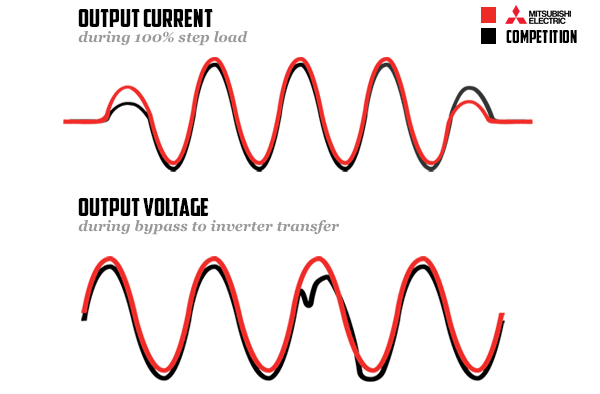BLOG
BLOG
AI’s Impact on Data Centers and the Increasing Demand for a Reliable UPS
MARCH 7, 2024
  |
by Michael Ruhe, Product Manager Engineered Solutions and Jack Bowen, Manager of Marketing & Planning |
The Rise of AI in Data Center Operations
With the emergence of AI, there has been no shortage of industry media highlighting the challenges that data centers face regarding power consumption and availability.
The International Energy Agency (IEA) is projecting that electricity consumption from data centers, AI, and the cryptocurrency sector could double by 2026 and surpass more than 1000 TWh.
And CBRE is reporting that data center construction timelines that ranged 1-3 years in 2015-2020, when ample power was available, are now being extended by 2-4 years – and in some cases by as many as 5 years – due to power availability constraints driven by consumption increases.

The Demand for Power
What is less often mentioned is how the nature and complexity of AI computation will test the resiliency of the data center’s power infrastructure to respond, essentially instantly, to changes in demand for power to support when AI services and applications are requested and executed.
Data centers that historically ran IT workloads consistently requiring 60-80% of designed power capacity with peak usage occurring during weekday business hours may now experience immediate power demands for full capacity at any time throughout the day.
These instantaneous changes in demand, referred to as step loads, can pose a challenge if the equipment in the critical power path is not designed or selected with this in mind. Everything from PDUs, static switches, and Uninterruptible Power Supplies (UPS) should be evaluated for performance during these load steps.
For example, if a UPS’s design is not up to the task, the resultant output voltage waveform can have undesired distortion.

This distortion, if severe enough, can cause issues with downstream equipment, such as static transfer switches or even the critical load itself.
Another often overlooked side effect is that the UPS might have to rely on the connected batteries to be able to handle these instantaneous load changes. These constant small discharges will decrease the service life of the battery system, requiring early replacement and more maintenance to verify their condition.
The influx of AI in data centers presents an even more significant demand on critical power equipment than before, forcing data center power distribution designs to reach new levels of performance and reliability.
Evaluating UPS Systems
A truly reliable UPS needs to have the means to withstand the data center industry’s fluctuating load demands. Control of the power electronics in a UPS is critical to achieving optimum performance characteristics for reliability, efficiency, and functionality to combat the stresses induced by these step loads.
The ideal control system uses full digital control of the converter and inverter sections and multiple feedback control loops with high-speed sampling.
With a sampling frequency of greater than 48kHz (800 times per cycle), the UPS can quickly detect changes in current, in addition to detecting deviations in the voltage, and quickly change the switching of the power electronics.
This provides complete control over the power conversion process. Since this control is done on both the converter and inverter sections, the UPS can simultaneously maintain a minimal amount of deviation on the output voltage and without requiring power from the battery system.

So, when selecting a UPS, make sure to verify with the manufacturer what the specification is for the output voltage deviation during full power step loads, and compare this against the specifications for the critical equipment.
Next, ask the manufacturer to demonstrate that the UPS can meet that specification without a battery system connected during factory testing and commissioning. A high-quality UPS system is always the first step in ensuring that a data center is protected from downtime.
However, new industry trends, such as AI will create greater demands on a UPS system, and facilities need to be prepared to face these new challenges.
Data centers providing AI services will increasingly experience step load conditions due to the intensity and complexity of the computing involved.
The data center’s critical load and power equipment are vulnerable under such conditions if the facility is not equipped with a reliable UPS system.
This makes choosing the right uninterruptible power supply even more critical in ensuring that data center service levels continue to be met as their infrastructure is increasingly challenged.

To eliminate these risks to keep up with AI’s demands, facilities should evaluate current and future critical equipment. This way, they can confirm that they are protected by a high-quality UPS system whose design and specifications are above par.
The process should encompass verifying with the manufacturer through project planning and proper testing to verify that the equipment will perform under the conditions imposed by AI.
Next Steps in Your Critical Power Journey
Selecting an uninterruptible power supply is crucial to protecting data center critical infrastructure and ensuring a continuous power supply for data center operations. It is a major decision and investment and requires a business to consider many aspects.
Below is a variety of recommended resources that may aid in the journey to maximum uptime despite industry changes and trends. And, of course, contact us with any questions or upcoming projects.
- AI’s Influence on UPS Battery Technology
- What Size UPS Do I Need? The Basics of Sizing a UPS
- Why Should You Invest in a Factory Witness Test?
Stay up-to-date on industry trends & insights
Be the first notified of new blog posts
By submitting this contact form, you agree that a representative(s) of Mitsubishi Electric Power Products, Inc. (MEPPI) may contact you using the information you provided. In accordance with our Privacy Policy, we will never share or sell your personal data.